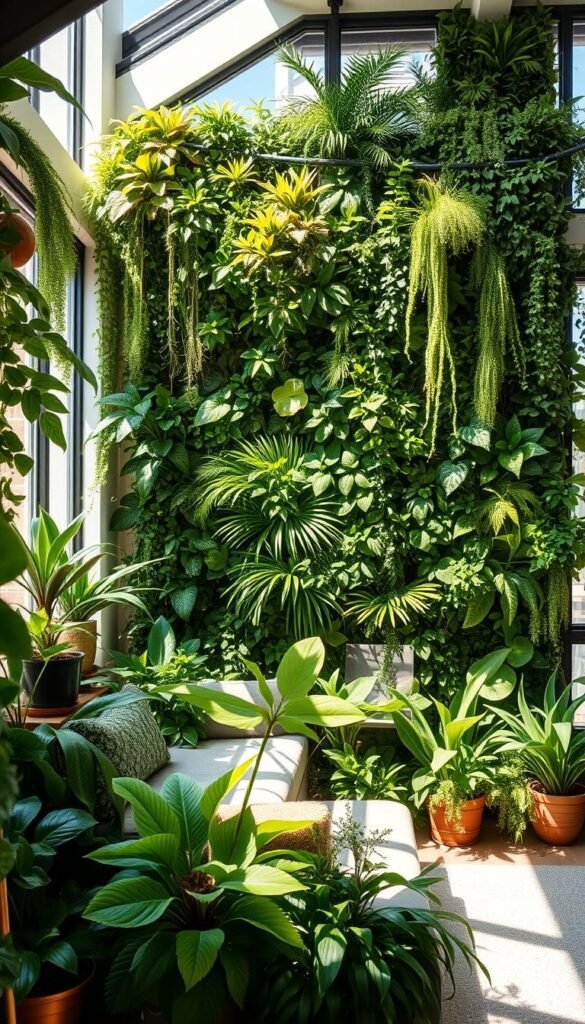Imagine transforming blank vertical spaces into lush, breathing art pieces that energize your home. Vertical gardens let you craft eye-catching displays using leafy arrangements tailored to your space. These installations turn empty walls into focal points bursting with color and texture.
Beyond their visual appeal, these structures work hard for you. Studies show they filter airborne toxins while releasing oxygen – like having a silent wellness partner built into your decor. Many urban dwellers report feeling calmer and more focused when surrounded by thriving foliage.
Modern systems make plant care simpler than ever. Self-watering setups and low-maintenance species keep your display vibrant without daily attention. Whether you prefer cascading vines or geometric succulent patterns, there’s a living wall solution matching every interior design style.
This guide reveals how to select plants that thrive in your light conditions, create stunning layouts, and maintain your vertical garden effortlessly. Discover how to blend functionality with striking aesthetics – no backyard required.
Why Indoor Green Walls Enhance Your City Living
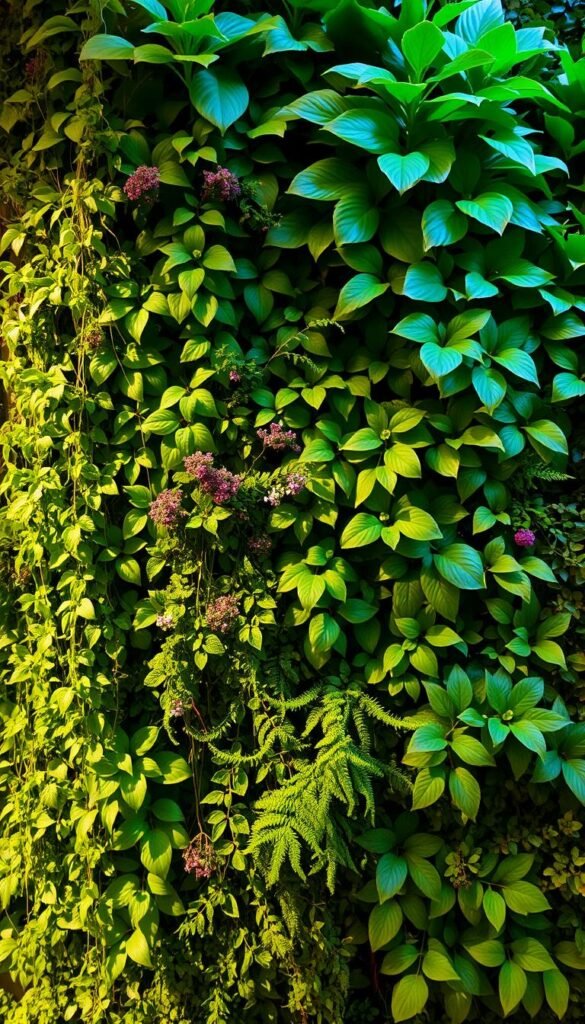
Picture a dynamic tapestry of foliage transforming sterile surfaces into wellness hubs. These breathing decor elements do more than just look pretty – they actively refresh your environment. NASA research reveals certain species remove up to 87% of airborne toxins within 24 hours, acting as natural air purifiers.
Visual Therapy Meets Clean Air
Your vertical garden becomes a mood-boosting focal point. The mix of trailing pothos and bold philodendron leaves creates movement that static art can’t match. As plants release moisture, they combat dry air from heating systems – a common issue in compact spaces.
Nature’s Stress Relief System
That calm feeling when walking through a park? You can recreate it daily. Studies show interacting with greenery lowers cortisol levels by 15%. Your living installation becomes a mindfulness anchor, its growth cycles reminding you to pause and breathe.
Urbanites often report better focus after adding plant walls. One Brooklyn resident described her studio: “The wall turned my concrete view into a jungle oasis. I sleep deeper and worry less.” Whether you choose ferns for their softness or snake plants for structure, these ecosystems adapt to your needs while elevating your space.
Understanding the Concept of Indoor Living Walls
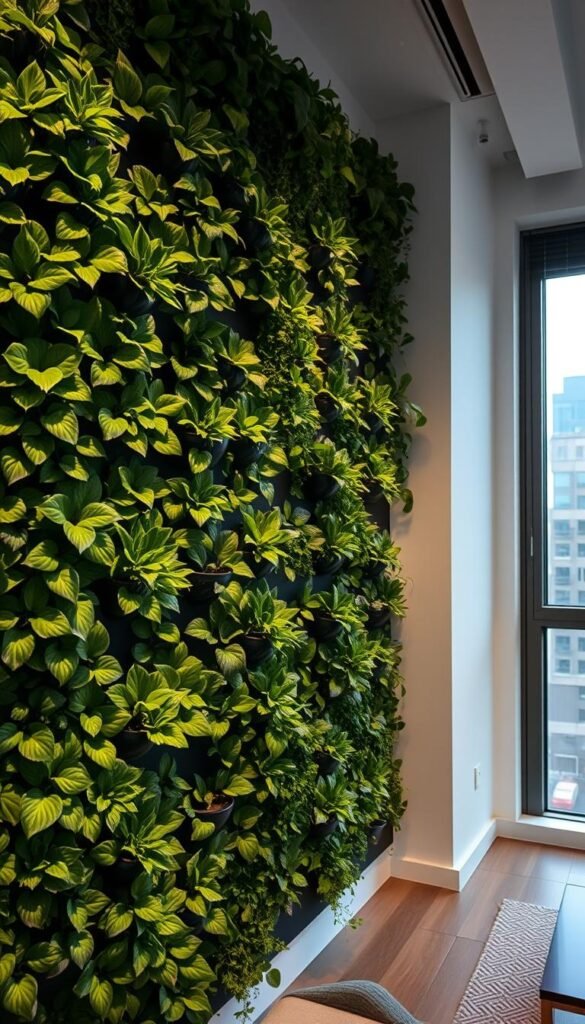
What exactly transforms a wall into a breathing part of your home? Living walls are engineered ecosystems where plants grow vertically using built-in irrigation and structural support. Unlike basic planters, these systems integrate soil substitutes, hydration networks, and drainage layers for sustained growth.
Defining Living Walls and Vertical Gardens
A true living wall functions as a cohesive unit. Plants share nutrients through hydroponic or soil-based matrices. Vertical gardens, however, often use individual containers like pockets or trays. This distinction affects maintenance: integrated systems require less frequent watering than modular setups.
Successful designs balance aesthetics with plant needs. Color gradients using coleus or nerve plants create visual flow. Texture contrasts – like pairing ferns with succulents – add depth. Always match species to your light conditions: pothos for dim corners, philodendrons for bright areas.
| Feature | Living Walls | Vertical Gardens |
|---|---|---|
| Structure | Integrated growing medium | Individual planters/pockets |
| Irrigation | Automated systems | Manual watering |
| Plant Variety | Limited by system type | More flexible options |
Commercial spaces often use large-scale hydroponic walls for air purification. Homes might favor framed moss panels or herb grids. One Seattle café features a 12-foot living wall with edible flowers – both decor and cocktail ingredients.
Indoor Green Walls: Bringing Nature Inside Your City Apartment
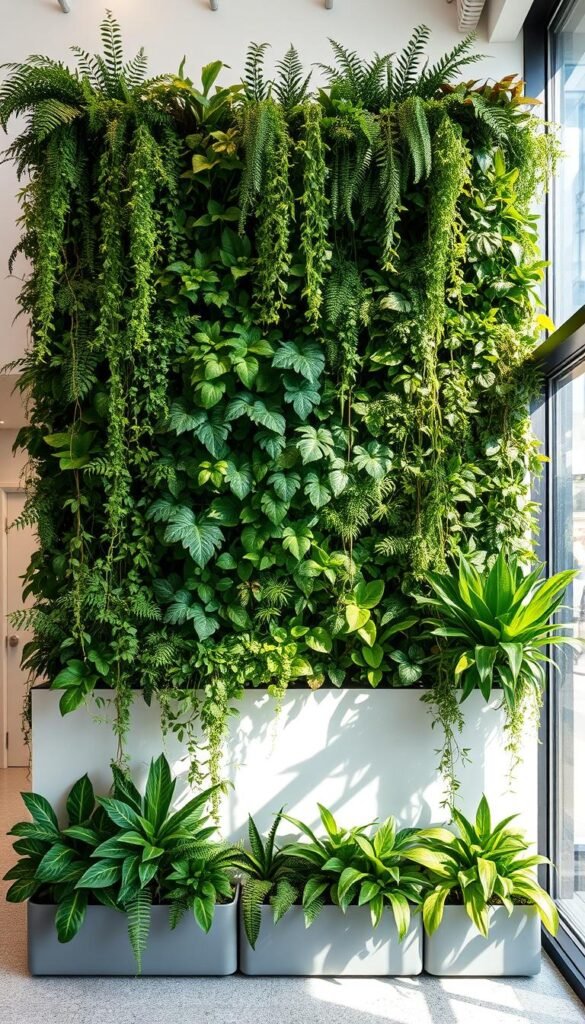
Transform your living space into a vibrant oasis that works as hard as it inspires. Vertical ecosystems blend natural beauty with practical benefits, turning unused surfaces into thriving focal points. These dynamic displays do more than catch the eye – they purify air, boost mood, and reconnect you with nature’s rhythms.
The magic lies in combining form and function. Your living wall becomes a self-sustaining art piece that filters pollutants while adding texture to rooms. Choose trailing ivy for soft movement or succulents for structured patterns – each arrangement reflects your style while improving air quality.
This guide simplifies the process of creating your own urban sanctuary. Learn to select species that thrive in your light conditions, design layouts that wow guests, and maintain your plants with minimal effort. No gardening degree required – just a willingness to reimagine what walls can do.
City living often means sacrificing greenery for square footage. But with smart vertical solutions, you gain both. Your installation becomes a daily reminder of nature’s resilience, adapting to tight spaces just like you do. Up next: discover the best systems for your needs and master installation techniques that ensure long-term success.
Exploring Various Living Wall Systems
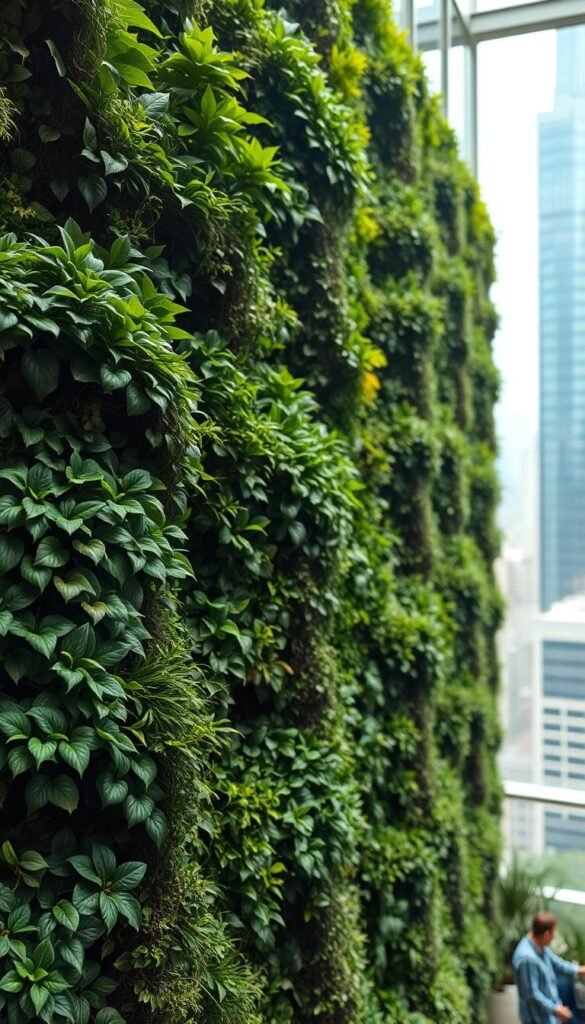
Urban spaces demand smart solutions that adapt to your lifestyle. Three primary setups dominate vertical gardening: modular, panel, and pocket systems. Each offers distinct advantages depending on your space, budget, and design goals.
Modular Systems: Build Your Vision
Think of these as plant LEGO blocks. Individual units snap together, letting you start small and expand over time. Perfect for renters or those testing the concept, modular setups allow easy rearrangement. Swap sections to experiment with color schemes or plant varieties without redoing the entire installation.
Panel Systems: Seamless Sophistication
Pre-assembled panels create uninterrupted greenery for bold statements. Ideal for large walls, these systems often include built-in irrigation. While installation requires more planning, the result feels like a natural extension of your architecture. Maintenance? Mostly automated – just refill the water reservoir weekly.
Pocket Systems: DIY Charm
Fabric pockets or hanging planters offer budget-friendly flexibility. Use them to craft organic shapes or mix textures. These work well for creative vertical gardening ideas, like herb walls in kitchens. While watering takes more effort, the hands-on approach appeals to tactile gardeners.
| Feature | Modular | Panel | |
|---|---|---|---|
| Installation | Easy | Professional | DIY |
| Maintenance | Moderate | Low | High |
| Versatility | High | Low | Medium |
| Cost | $$ | $$$ | $ |
Choose modular for flexibility, panels for drama, or pockets for affordability. Your selection shapes how your living ecosystem evolves – and how much time you spend nurturing it.
Choosing the Ideal Location and Lighting for Your Green Wall
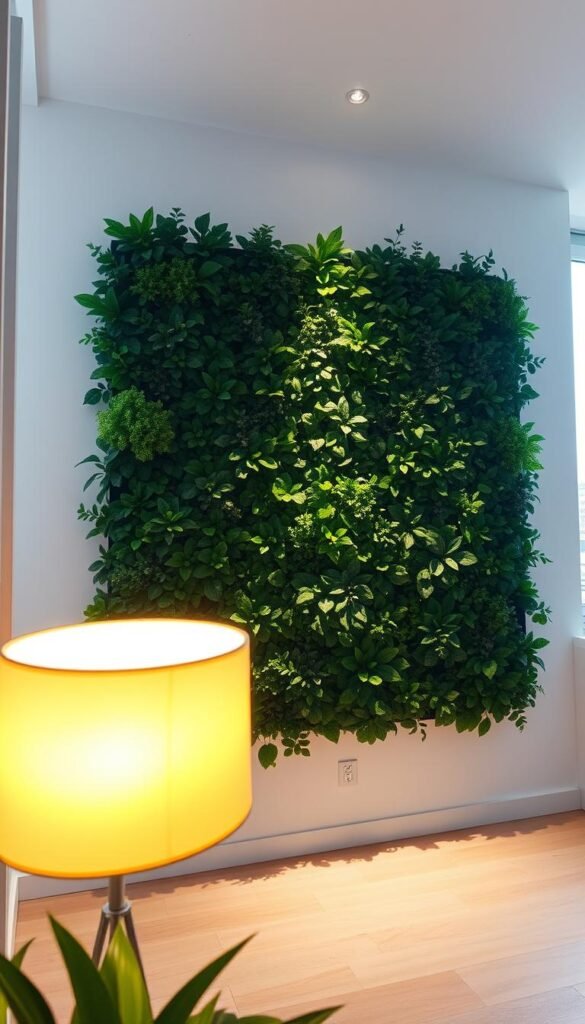
Your vertical garden’s success starts with smart positioning—where you place it determines how well your plants thrive. Light acts as their food source, shaping growth patterns and leaf vibrancy. Too little, and plants become leggy; too much, and leaves scorch. Balance is key.
Natural Light vs. Artificial Light
South-facing windows deliver intense brightness perfect for succulents and flowering species. North-facing areas suit low-light plants like pothos. If your space gets limited natural light, LED grow lights offer a lifeline. They mimic sunlight spectrums without overheating leaves.
| Light Type | Best For | Setup Cost | Maintenance |
|---|---|---|---|
| Natural | Herbs, flowering plants | $0 | Seasonal adjustments |
| LED Grow Lights | Shady corners, ferns | $$ | Timer setup |
| Fluorescent | Seedlings, leafy greens | $ | Bulb replacements |
Optimal Wall Placement Strategies
Position your installation where light spreads evenly—usually 3-6 feet from windows. Rotate plants weekly if using one-sided natural light. For artificial setups, mount lights 12-18 inches above foliage. Dark corridors? Use slim LED panels on timers for 12-hour daily cycles.
Remember: walls near heat vents or AC units stress plants. Track sunlight patterns for 3 days before finalizing your spot. Your green wall will reward strategic placement with lush, vibrant growth.
Selecting the Perfect Plants for Your Indoor Living Wall
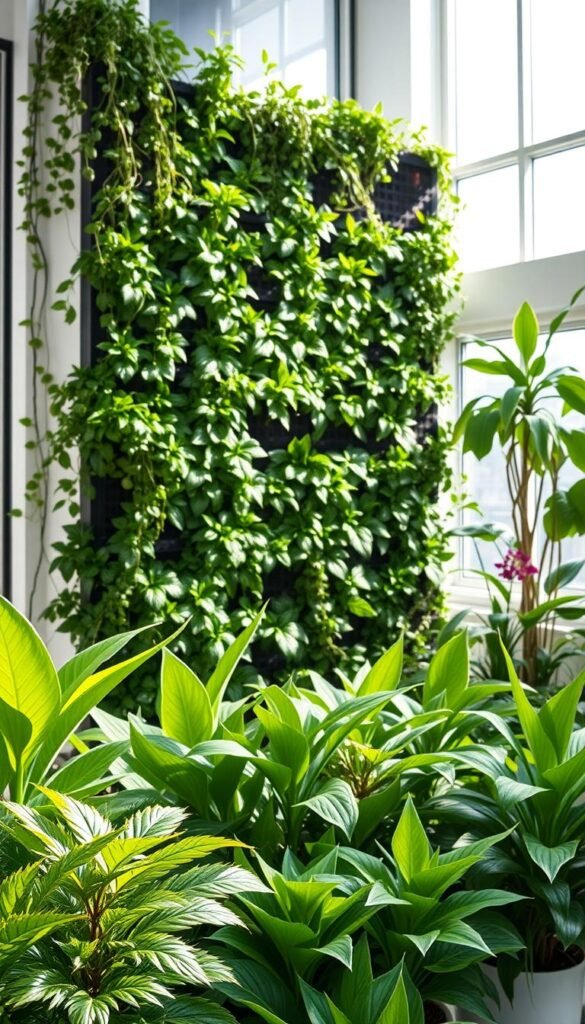
Which leafy companions will thrive in your vertical setup? The secret lies in matching species to your space’s light levels and maintenance capacity. Smart plant selection creates a self-sustaining display that grows more beautiful each month.
Low-Light and High-Light Plant Options
Dim corners come alive with shade-loving varieties. Ferns unfurl delicate fronds in north-facing areas, while pothos vines cascade dramatically with minimal care. These resilient choices tolerate irregular watering and indirect light.
Sun-drenched walls demand tougher species. Spider plants thrive in bright spots, purifying air as they grow. Succulents like echeveria form rosette patterns that catch the eye – just ensure they get 4+ hours of direct light daily.
| Light Level | Top Picks | Water Needs | Growth Speed |
|---|---|---|---|
| Low | Pothos, Ferns, ZZ Plant | Weekly | Moderate |
| Medium | Philodendron, Peperomia | Bi-Weekly | Slow |
| High | Succulents, Spider Plant | Monthly | Fast |
Mix textures for visual impact. Pair trailing ivy with upright snake plants to create depth. Pro tip: Include at least one air-purifying species like peace lilies to boost your wall’s health benefits.
Choose plants with similar care needs to simplify maintenance. Drought-tolerant varieties reduce watering frequency, while slow growers need less pruning. Your living wall becomes easier to manage when plants work as a team.
Ensuring Structural Support and Managing Weight Considerations
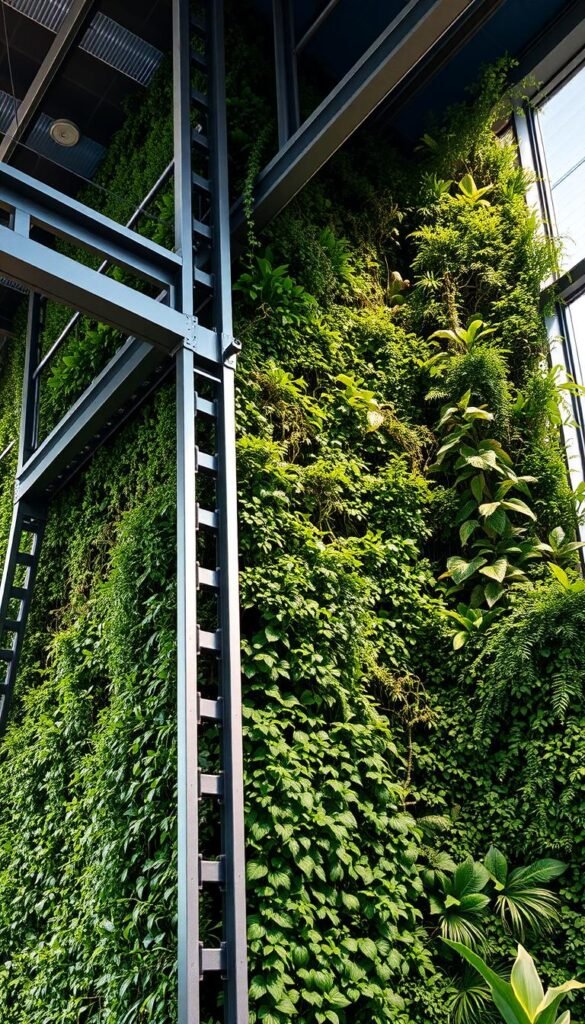
Creating a thriving vertical garden starts with a solid foundation—literally. Before hanging your first planter, assess your wall’s ability to handle the load. Drywall alone won’t cut it; you’ll need to locate studs or use heavy-duty anchors rated for at least twice your system’s expected weight.
Choosing Durable Materials and Mounting Techniques
Pressure-treated wood frames or powder-coated metal brackets offer reliable support for planters. Interior designer Mara Chen advises: “Always use rust-proof hardware in humid environments. Water adds significant weight—a fully saturated system can weigh 15 lbs per square foot.”
Secure mounting prevents accidents. Attach vertical rails directly to wall studs, then snap planters into place. For concrete walls, epoxy-coated anchors provide superior grip. Leave 2-3 inches between the wall and planters for airflow—this reduces moisture buildup that could damage surfaces.
Regular maintenance checks keep your display safe. Every 3 months, test anchor tightness and look for stress cracks in materials. Rotate planters evenly to distribute weight shifts caused by growth patterns. Pair these steps with smart container gardening ideas to maximize stability in compact spaces.
Humidity plays a double role—it benefits plants but challenges materials. Use marine-grade plywood or UV-stabilized plastics in steamy bathrooms. In dry rooms, seal wooden frames to prevent warping. Your living wall’s lifespan depends on matching materials to your home’s unique conditions.
Step-by-Step Guide to Installing Your Living Wall
Ready to turn that empty vertical space into a thriving ecosystem? Proper planning ensures your plants grow healthy while keeping installation time manageable. Let’s break down the process into simple, achievable stages.
Preparation, Tools, and Material Checklist
Gather these essentials before starting:
- Measuring tape & level for precise layout
- Stud finder and heavy-duty wall anchors
- Modular frame system or pre-built panels
- Plants (use your pre-made selection)
- Watering can with narrow spout
| Task | Time Needed | Key Tip |
|---|---|---|
| Wall prep | 30 mins | Mark studs with painter’s tape |
| Frame mounting | 1-2 hours | Double-check levelness |
| Planting | 45 mins | Start from bottom row |
Installation Process: From Frame to Planting
- Measure your wall space, allowing 6″ clearance from ceilings
- Mark anchor points using a laser level for perfect alignment
- Secure the frame with toggle bolts (for drywall) or concrete screws
- Insert plants into pockets or modules, spacing them 4-6″ apart
Water thoroughly after planting, focusing on root zones. During the first month, check soil moisture every 3 days – consistent care helps roots establish. Rotate plants weekly if light comes from one direction to ensure even growth.
Setting Up an Effective Irrigation System
Watering your vertical garden doesn’t have to feel like a chore – the right setup keeps plants thriving with minimal effort. Proper hydration prevents root rot while ensuring nutrients reach every leaf. Without consistent moisture, even hardy species may struggle to maintain their vibrant appearance.
Hand Watering vs. Set-and-Forget Solutions
Manual watering works for small installations but demands daily attention. A spray bottle or watering can lets you spot-check soil moisture. However, uneven distribution may leave some plants parched while others drown. Irrigation specialist Laura Green notes: “Drip systems cut water waste by 50% while preventing overwatering mishaps.”
| Method | Time Required | Cost | Efficiency |
|---|---|---|---|
| Manual | Daily checks | $10-$30 | Variable |
| Drip | Weekly monitoring | $50-$200 | Consistent |
Automated setups use four key components:
- Adjustable tubing that snakes behind planters
- Micro-emitters targeting root zones
- Programmable timer for scheduled watering
- Drainage tray to catch excess moisture
Ensure even coverage by testing emitter flow rates before finalizing your layout. Group plants with similar thirst levels – ferns and peace lilies often pair well. Conceal tubing along frame edges or paint it to match your wall color for seamless integration.
Compact spaces benefit from vertical drip lines and narrow reservoirs. Wall-mounted systems save floor area while keeping hoses tidy. Remember: your irrigation choice should match both plant needs and lifestyle demands.
Optimizing Indoor Lighting for Plant Growth
What powers your vertical garden’s growth more than water or fertilizer? Light acts as the engine driving photosynthesis and leaf development. While natural sunlight works best, most urban spaces need supplemental lighting to keep plants thriving year-round.
Matching Lights to Leafy Needs
LEDs dominate modern setups for good reason. They emit full-spectrum light that mimics the sun’s rays, helping herbs and tropical species flourish. Fluorescent tubes work well for low-light ferns, while incandescent bulbs suit flowering plants needing warmth.
| Light Type | Best For Plants | Energy Cost | Lifespan |
|---|---|---|---|
| LED | Leafy greens, succulents | $$$ | 50,000 hours |
| Fluorescent | Ferns, herbs | $$ | 10,000 hours |
| Incandescent | Flowering varieties | $ | 1,000 hours |
Position lights 12-18 inches above foliage for even coverage. Use timers to create day/night cycles – 14 hours on for most species. Rotate plants weekly if your setup uses one-sided lighting.
LEDs save up to 60% energy versus traditional bulbs. Horticulturist Dr. Ellen Park notes: “Full-spectrum LEDs accelerate growth rates by 30% compared to fluorescents.” Pair lights with reflective surfaces like white walls to boost intensity without extra costs.
Watch for leaf discoloration – yellowing suggests too much light, while leggy stems demand brighter conditions. Adjust your setup seasonally as daylight shifts. Your living display will reward optimized lighting with lush, vibrant textures.
Maintenance and Long-Term Care of Your Indoor Green Wall
Keep your living wall thriving with a smart care routine that prevents issues before they arise. Regular checks ensure plants stay healthy while maintaining your display’s visual appeal. Think of it as weekly wellness visits for your leafy friends.
Troubleshooting Common Issues
Stick to this maintenance schedule for best results:
- Daily: Check soil moisture with your finger
- Weekly: Remove yellow leaves and rotate plants
- Monthly: Flush irrigation lines to prevent clogs
Spotting trouble early saves plants. Mushy stems signal root rot – reduce watering immediately. Crispy leaves? Increase humidity with pebble trays or misting. Wipe dust off leaves every 2 weeks to maintain photosynthesis efficiency.
| Problem | Solution | Prevention |
|---|---|---|
| Uneven growth | Rotate plants weekly | Use reflective surfaces |
| White crust on soil | Flush with distilled water | Use filtered water |
| Pest outbreaks | Apply neem oil spray | Inspect new plants |
Indoor gardening expert Dr. Helen Park advises: “Monitor conditions like temperature swings – sudden changes stress plants.” Keep thermometers near your display and aim for 65-75°F. Seasonal adjustments matter – water less in winter when growth slows.
Proactive care extends your wall’s lifespan. Schedule quarterly deep cleanings – sanitize frames and replace worn components. Your living masterpiece will reward consistent attention with year-round vibrancy.
Integrating Biophilic Design Principles into Your Space
Ever feel like your home could use a deeper bond with the outdoors? Biophilic design goes beyond potted plants – it crafts meaningful connections between your living areas and Earth’s rhythms. This approach blends organic shapes, natural light, and living elements to create spaces that feel inherently human.
Natural Materials That Speak to the Senses
Swap plastic accents for walnut shelves or slate coasters. Rough-hewn wood beams add warmth, while river rock tiles underfoot mimic forest paths. These textures ground your design in authenticity, making rooms feel like extensions of natural environments.
Greenery as Wellness Architecture
Living walls become more than decor – they’re nature-infused stress relievers. Studies show offices with vertical gardens see 37% fewer sick days. At home, position ferns where morning light dances across their fronds, creating daily moments of calm.
Seattle’s biophilic architecture movement proves this works at scale. One loft complex uses reclaimed barnwood walls with integrated planters, reducing noise by 50% while boosting air quality. Your space can achieve similar harmony through thoughtful material choices and leafy accents.
Wrapping Up Your Green Wall Journey and Embracing Next Steps
You’ve now got all the tools to turn lifeless walls into thriving ecosystems that work while you relax. These living installations boost air quality, reduce stress, and spark creativity – transforming your space in powerful ways. Whether you start with a petite herb grid or a full-panel display, the time to act is today.
Remember: success comes from smart planning. Choose plants matching your light, secure proper support, and set up efficient watering. Regular care keeps your display vibrant with minimal effort. As architect Lainey Richardson notes, “These systems look stunning immediately – no waiting for growth.”
Ready for next steps? Explore biophilic design principles to deepen your connection with nature. Join local workshops or dive into content about eco-conscious living. Your efforts create ripple effects – fresher air, calmer moods, and a healthier environment for all.
Start small if needed. Even a single modular planter proves that every vertical inch holds potential. What way will you reimagine your walls this week?

